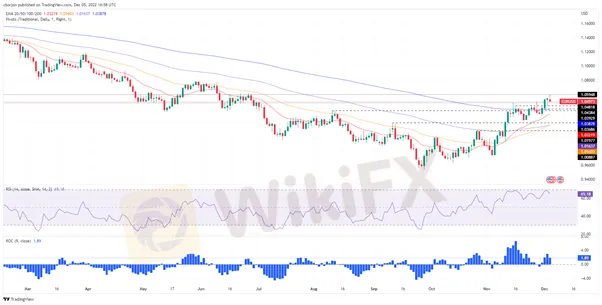EUR/USD falls on robust US ISM Services data, tumbles below 1.0500
Zusammenfassung:EUR/USD is the forex ticker that tells traders how many US Dollars are needed to buy a Euro. The Euro-Dollar pair is popular with traders because its constituents represent the two largest and most influential economies in the world.

Highlight
• The Euro is falling against the US Dollar after hitting a six-month high nearby 1.0600.
• US ISM Non-Manufacturing activity surprisingly jumped in the United States.
• Eurozone data was mixed, though tilted negative as Retail Sales dropped.
• EUR/USD Price Analysis: Upward biased, but could pull back to 1.0400 before testing 1.0600.
EUR/USD is the forex ticker that tells traders how many US Dollars are needed to buy a Euro. The Euro-Dollar pair is popular with traders because its constituents represent the two largest and most influential economies in the world
Currently, the Euro (EUR) is almost unchanged against the US Dollar (USD) following the release of an upbeat US ISM Services PMI that underpinned the USD, while last weeks solid November US employment report shows the labor market remains tight. At the time of writing, the EUR/USD is trading at 1.0494, down by 0.40%.
US ISM Services was better than expected, weighed on the Euro
US ISM Services was better than expected, weighed on the Euro. Sentiment remains deteriorated, even though China is beginning to ease Covid-19 measures. The US ISM Non-Manufacturing Index for November rose by 56.5, above estimates of 53.3, crushing Octobers 54.4.
According to the reporters “The service sector expanded at a faster pace in November, with the holiday season bolstering business activity.” It should be noted that the price index subcomponent confirmed that inflationary pressure is skewed to the upside.
On the economic data release, the EUR/USD dived from around 1.0550 to 1.0503.
At the same time, US Factory Orders grew by 1% in November against expectations of a 0.7% increase and also smashed Septembers data of 0.3%. “New orders for manufactured durable goods in October, up seven of the last eight months, increased $3.0 billion or 1.1%to $277.4 billion, up from the previously published 1% increase,” the publication further read.
Apart from this, last week‘s employment report, November’s Nonfarm Payrolls (NFP) rose by 263K, beating the 200K estimates, while the Unemployment Rate, at 3.7%, remained unchanged. Average Hourly Earnings increased by 5.1%, vs. 4.9% forecasts, which would keep the US Federal Reserve (Fed) lifting rates, even if it means at 50 bps increases, as the Federal Reserve (Fed) Chair Jerome Powell said last Wednesday.
At the time now, across the pond, S&P Global PMIs Services and Composite indices across the Eurozone remained unchanged, while the Euro area Retail Sales came worse than expected, at -1.8% MoM vs. -1.7% foreseen and -2.7% YoY, below -2.6% estimated. Additionally, several European Central Bank (ECB) officials, Villeroy and Makhlouf, backed a 50 bps rate hike in the December meeting.
EUR/USD Price Analysis: Technical outlook
From a technical perspective, the EUR/USD daily chart is neutral-upward biased after breaking above the 200-day Exponential Moving Average (EMA) at 1.0388. As the EUR/USD rose to six-month highs at 1.0594, registering successive series of higher highs, oscillators like the Relative Strength Index (RSI) and the Rate of Change (RoC) did not, so a negative divergence between price action/oscillators, emerged.
Therefore, the EUR/USD first support would be the 1.0500 figure, followed by the December 2 daily low at 1.0428 and the 1.0400 psychological figure.

Tag : EURUSD | Majors | Macroeconomics | Currencies | Technical Analysis

WikiFX-Broker
Aktuelle Nachrichten
Bitcoin und Ethereum verzeichnen Kursverluste, nachdem die Fed eine „vorsichtige Zinssenkung” vorgenommen hat
Aave Preis-Prognose: AAVE ist bereit für einen Ausbruch, da sich die bullischen Signale verstärken
Ripple-Preisprognose: XRP konsolidiert über der Unterstützung von 2,00 USD
Oracles Kurssturz ist ein weiteres Warnsignal für KI-Investoren
Solana-Preisprognose: SOL fällt, da die hawkishe Geldpolitik der Fed die Marktstimmung dämpft
Bitcoin-Preisprognose: BTC fällt auf 90.000 USD, da die hawkishe Haltung der Fed den Risiko appetit dämpft
Wechselkursberechnung


